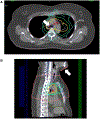Magnetic resonance linear accelerator technology and adaptive radiation therapy: An overview for clinicians
- PMID: 34792808
- PMCID: PMC8985054
- DOI: 10.3322/caac.21707
Magnetic resonance linear accelerator technology and adaptive radiation therapy: An overview for clinicians
Abstract
Radiation therapy (RT) continues to play an important role in the treatment of cancer. Adaptive RT (ART) is a novel method through which RT treatments are evolving. With the ART approach, computed tomography or magnetic resonance (MR) images are obtained as part of the treatment delivery process. This enables the adaptation of the irradiated volume to account for changes in organ and/or tumor position, movement, size, or shape that may occur over the course of treatment. The advantages and challenges of ART maybe somewhat abstract to oncologists and clinicians outside of the specialty of radiation oncology. ART is positioned to affect many different types of cancer. There is a wide spectrum of hypothesized benefits, from small toxicity improvements to meaningful gains in overall survival. The use and application of this novel technology should be understood by the oncologic community at large, such that it can be appropriately contextualized within the landscape of cancer therapies. Likewise, the need to test these advances is pressing. MR-guided ART (MRgART) is an emerging, extended modality of ART that expands upon and further advances the capabilities of ART. MRgART presents unique opportunities to iteratively improve adaptive image guidance. However, although the MRgART adaptive process advances ART to previously unattained levels, it can be more expensive, time-consuming, and complex. In this review, the authors present an overview for clinicians describing the process of ART and specifically MRgART.
Keywords: 0.35 Tesla MR Guidance; 1.5 Tesla MR Guidance; RT adaption; Unity; ViewRay; adaptive image guidance; adaptive radiation therapy; magnetic resonance (MR)-guided radiation; personalized radiation therapy.
© 2021 The Authors. CA: A Cancer Journal for Clinicians published by Wiley Periodicals LLC on behalf of American Cancer Society.
Figures











References
-
- Delaney G, Jacob S, Featherstone C, Barton M. The role of radiotherapy in cancer treatment: estimating optimal utilization from a review of evidence-based clinical guidelines. Cancer. 2005; 104:1129–1137. - PubMed
-
- Siegel RL, Miller KD, Jemal A. Cancer statistics, 2020. CA Cancer J Clin. 2020; 70:7–30. - PubMed
-
- Alvarnas J From the editor-in-chief: oncology in the time of “Moore’s Law.” Am J Manag Care. 2019;25(5 spec no.): Sp140. - PubMed
-
- Abshire D, Lang MK. The evolution of radiation therapy in treating cancer. Semin Oncol Nurs. 2018;34:151–157. - PubMed
-
- Gardner SJ, Kim J, Chetty IJ. Modern radiation therapy planning and delivery. Hematol Oncol Clin North Am. 2019; 33:947–962. - PubMed
Publication types
MeSH terms
Grants and funding
- OT2 OD026675/OD/NIH HHS/United States
- P30 CA016672/CA/NCI NIH HHS/United States
- F31 DE029093/DE/NIDCR NIH HHS/United States
- R01 CA214825/CA/NCI NIH HHS/United States
- R01 HL153720/HL/NHLBI NIH HHS/United States
- R01 CA225190/CA/NCI NIH HHS/United States
- R21 CA256144/CA/NCI NIH HHS/United States
- R01 CA257814/CA/NCI NIH HHS/United States
- R01 DE028290/DE/NIDCR NIH HHS/United States
- TL1 TR003169/TR/NCATS NIH HHS/United States
- 28284/CRUK_/Cancer Research UK/United Kingdom
- R01 DE025248/DE/NIDCR NIH HHS/United States
- R21 DE031082/DE/NIDCR NIH HHS/United States
- R25 EB025787/EB/NIBIB NIH HHS/United States
- KL2TR001438/NH/NIH HHS/United States
- R01 CA218148/CA/NCI NIH HHS/United States
- R43 CA254559/CA/NCI NIH HHS/United States
- R01 CA258827/CA/NCI NIH HHS/United States
- R01 CA204189/CA/NCI NIH HHS/United States
- KL2 TR001438/TR/NCATS NIH HHS/United States

